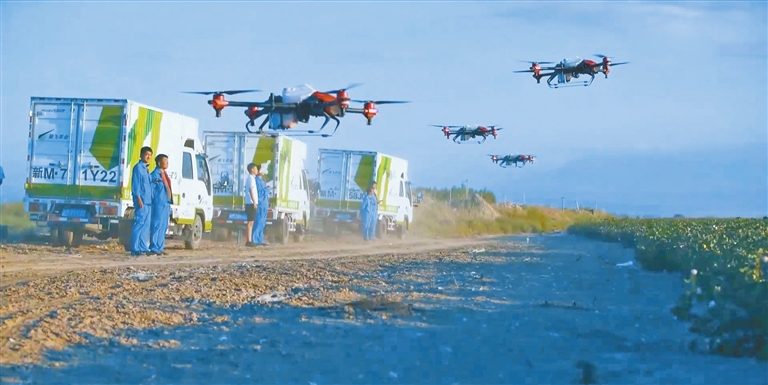
YANG HAORAN has a dream job that many little boys aspire to. He spends most of his days flying unmanned aerial vehicles (UAVs) over vast croplands in Northwest China’s Xinjiang Uygur Autonomous Region. Since the spring sowing of cotton seeds started in the north of Xinjiang, Yang has been busy operating his fleet of drones, which can cover over 200,000 square meters of cotton fields. Yang, a skilled worker born in the 1990s, is based in Shawan City, a major cotton-producing area in northern Xinjiang with about 1,167 square kilometers of cotton fields. He uses his UAVs to spray fertilizer, pesticide, and defoliant in cotton and wheat fields. According to him, using drones instead of tractors saves farming time, labor, and water, and is more cost-effective. “A single drone with a payload of 40 kilograms can handle more than 666,667 square meters of cotton farm in a day. Some drone operators can earn about 200,000 yuan (US$28,200) a year,” Yang says. Yang’s upbringing was in a family of cotton farmers, where he spent his childhood playing in the cotton fields. He observed firsthand the difficulty his parents faced while using traditional farming methods and how automation has improved productivity and saved labor. After graduating from university, Yang returned to his hometown to become a cotton farmer himself. He manages over 200,000 square meters of cotton fields, much more than his parents and grandparents could handle, and is always looking for ways to improve efficiency through technological innovations. In 2018, Yang recognized the significant business potential of using drones in farming and founded his own company. The firm employs 13 drone operators, all young people similar to Yang. Yang takes pride in the diverse ethnic background of his team, which includes members from different ethnic groups like Han, Hui and Kazak, remarking, “We are like a big family.” During peak growing seasons, Yang’s team skillfully guides their drones over the cotton fields. During the off-season, he teaches local farmers to utilize UAVs to improve agricultural yields. Over the past three years, Yang’s team has trained hundreds of local farmers to operate agricultural drones, with all training expenses covered by the local government. “This will enable more farmers to acquire new technologies and modern equipment, allowing them to keep pace with the advancements in modern agriculture and increase their income,” Yang says. Yang’s goals go beyond teaching drone operation. He has taken up a precision farming project that utilizes drones to collect data for spectral analysis. Real-time data on crop growth and soil moisture is transmitted to the irrigation and fertilizer equipment for precision agriculture, increasing the efficiency of the farming process. Xinjiang is responsible for 90% of China’s total cotton output, covering one-sixth of the country’s territory. Aside from drones, Xinjiang also uses satellite navigation and large-scale agricultural machines to boost cotton production. Data from the region’s agriculture and rural affairs authorities shows that 90% of the cotton cultivation and harvest is carried out by machines. (Xinhua) | 
